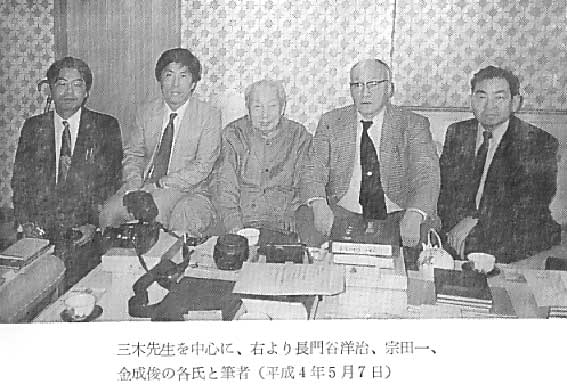Miki Sakae(三木榮, 1901-1984) was a Japanese historian and medical historian who made significant contributions to the study of medical history, particularly in the field of Korean medicine. Born in Hyogo Prefecture in Japan, Miki Sakae studied at the prestigious Tokyo Imperial University (now the University of Tokyo), where he majored in history. After completing his studies, he embarked on a long and successful academic career, teaching at various institutions, including Kyoto University and Waseda University, where he served as a professor and later as the head of the history department. He retired in 1965 and was granted the title of professor emeritus by both Kyoto University and Waseda University.[1]
 |
| https://square.umin.ac.jp/mayanagi/paper04/mikisensei.html |
At the time, the study of Korean medicine and the history of medicine in Japan was very limited, with little research conducted not only in Japan but also in Korea[2]. The Korean culture, science, and technology was largely unknown. Miki Sakae lived on the Korean Peninsula for 16 years from 1928 and worked alone to elucidate the situation. He published "Chosun Igaku Shi Shi(朝鮮醫書誌)" (1956) and "Chosun Igaku Shi to Shiryo Shi(朝鮮醫學史及疾病史)" (1963), which have been highly regarded both in Japan and Korea.
Miki sakae's affection and interest in Dongbogam was very special. He evaluated that
"Korean medicine at that time, which was completely dependent on Chinese medicine, with the advent of Heo Jun, deduced the new theories of the Ming Dynasty based on ancient theories, added unique Korean theories and modalities to it, penetrated and unified it with the spirit of practical learning, and established a groundbreaking medicine, and it is Dongbogam that embodied it". [3]
It is said that Miki Sakae, while writing letters to his acquaintances, always wrote 'a dozen letters' in red ink at the end as a signature, saying, "We could not speak of Japanese and Chinese medicine without knowing Korean medicine" (不通朝鮮半島醫學 不可 以說日本及中國醫學) (三木先生を追慕して 醫譚 1993 64). In the living room of his home in Osaka, where he died, a large portrait of Heo Jun hung on the wall visible from the front door (長門谷洋治 三木先生を訪ねして 日本醫史學雜誌 1993 39(2) 246) [4]
In his lifetime, Miki Sakae contributed significantly to the understanding of the history of Korean medicine in Japan. He was awarded the Korean Society for Science and Technology Studies Appreciation Award and the Japanese Society for Medical History Achievement Award[2][5]. His work continues to impact the field, as his research shed light on the importance of Korean medicine and its influence on the development of Japanese and Chinese medical history. Through his dedication and passion for the subject, Miki Sakae remains an essential figure in the field of medical historiography and has earned the respect of scholars in Japan and Korea.
Major Works
- 三木栄 published works such as “History of Korean Medicine and Disease” and “Korean Medical Bibliography”
- Miki Sakae, "朝鮮医書誌" (Bibliography of Korean Medical Books), Gakujutsu Tosho Kankokai, 1956.
- Miki Sakae, "朝鮮医学史及疾病史" (History of Korean Medicine and Disease), 1963.
- Miki Sakae, "体系・世界医学史" (Systematic History of World Medicine), Ishiyaku Publishers, 1972.
 |
| 三木栄(三木榮) 著書2点 『朝鮮医学史及疾病史』 |
References:
[1] 三木榮 デジタル版 日本人名大辞典+Plus 講談社
[2] 紹介『朝鮮医事年表』真柳誠 「科学史研究」25巻2号
[3] 동의보감의 의사학적 가치, 원진희, 동아시아 의학의 정수
[4] 김호(2005), 의사학자 삼목영의 생애와 조선의학사급질병사, 의사학 14, 101-122
[5] https://www.thelancet.com/journals/lancet/article/PIIS0140673608612933/fulltext
미키 사카에(Miki sakae)의 동의보감에 대한 애정과 관심은 매우 컸다. 그는 “중국 의학에 전적으로 의존하고 있던 당시의 조선 의학이 허준의 출현으로 명나라의 새로운 학설 을 근본으로 고금의 학설을 연역(演繹)하고, 여기에 조선 의학을 가미하여 실학 정신으로 관통, 통일하여 획기적인 의학을 수립 하였는데, 그것을 구체화한 것이 바로 『동의보감』이다.”라고 평가하였다. (동의보감의 의사학적 가치, 원진희, 동아시아 의학의 정수)
일본의 의사학자 미키 사카에는 지인들에게 편지를 쓰면서 마지막에는 항상 조선 의학을 모르서고서는 일본의학과 중국 의학을 말할 수 없다 (不通朝鮮半島醫學 不可 以說日本及中國醫學) 는 십여자의 글자를 붉은색 잉크로 써서 보냈다고 한다(5. 三木先生を追慕して 醫譚 1993 64) 그가 마지막으로 숨을 거둔 오사카의 자택 거실에는 현관에서 들어서면 보이는 벽면에 커다란 허준의 영정이 걸려 있었다고 한다(5, 長門谷洋治 三木先生を訪ねして 日本醫史學雜誌 1993 39(2) 246) (김호(2005), 의사학자 삼목영의 생애와 조선의학사급질병사, 의사학 14, 101-122)